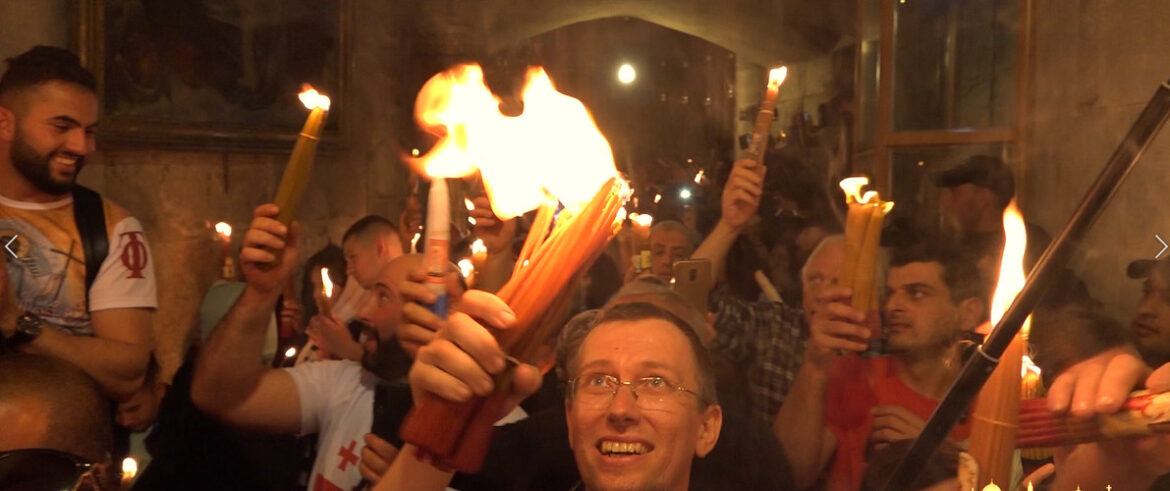The Holy Fire Ceremony, an ethereal spectacle held annually at the Church of the Holy Sepulchre in Jerusalem, captivates the hearts and minds of countless pilgrims and onlookers from around the globe. Every year, as the Orthodox Christian community commemorates Holy Saturday, the miracle of the Holy Fire unfolds, intertwining the profound elements of faith, mystery, and tradition. This age-old event beckons believers and seekers alike to ponder the nature of divine intervention and the enduring significance of sacred rituals.
At its core, the Holy Fire is a palpable manifestation of hope and renewal. It is a moment steeped in rich theological implications, yet expressed through a simple yet overwhelming phenomenon: an inexplicable flame that becomes spontaneously ignited in the presence of the Patriarch of Jerusalem. This descent of the Holy Fire, draped in layers of tradition, symbolizes the resurrection of Jesus Christ and serves as a beacon for all Christians who look upon it as a sign of divine grace. The flickering light offers more than mere illumination; it serves as a metaphor for spiritual enlightenment, illuminating the path for those wandering through the darkness of doubt and despair.
The ceremony itself unfolds amidst an atmosphere thick with anticipation. As the sun dips beneath the horizon, congregants gather in the dimly lit church, their hearts a cacophony of fervent prayers and whispered hopes. The air is saturated with an ineffable tension, a reverberation of centuries of reverence and devotion. The Patriarch emerges within the edifice, donning vestments that shimmer like celestial fabrics. In this grand historical setting, the flickering shadows dance across the ancient stone walls, evoking a profound sense of continuity—a tangible connection between past and present.
The Holy Fire is not simply an act of celebration; it is steeped in rich, symbolic resonance. One can liken it to a phoenix rising from the ashes, embodying themes of death and rebirth. The moment the flame ignites is akin to the heart-stopping instant of revelation, reminiscent of epiphany itself. It compels the faithful to reconsider the transformative power of resurrection, in both a historical and personal context. It reminds us that, much as Christ overcame death, we too can rise from our own trials and tribulations, igniting the fires of hope within.
Despite its profound significance, the miracle of the Holy Fire invites scrutiny and skepticism. Modern observers may challenge the supernatural aspects of the event, probing into the plausibility of the flame’s origins. Some speculate that the fire is a mere trick of light, a product of theatrical invention. Yet, therein lies the mystery that envelops the tradition. It is not solely about the physical manifestation of the fire but the emotive and spiritual resonance it conjures within the hearts of believers. The elements of faith often tread the fringes of the explicable; they weave tales that stretch beyond the constraints of rational understanding, enveloping adherents in a tapestry of hope and inspiration.
The venerable church itself, a majestic cradle for such an event, deserves articulation. Built over the site traditionally believed to be where crucifixion and resurrection occurred, the Church of the Holy Sepulchre is a veritable palimpsest of apostolic history. Each stone and relic speaks volumes of devotion, fervor, and sacred moments captured in time. To witness the Holy Fire in this hallowed space is to navigate a labyrinthine journey through the annals of Christian heritage—a journey defined by grace, prophecies fulfilled, and legacies left behind.
As the flame is distributed amongst the assembled congregants, a sense of community envelops the participants. Candles are ignited, sequentially passing the light akin to sharing a sacred torch among the faithful. In that moment, barriers dissolve, and divisions among denominations seem trivial. The collective act asserts a unified belief in the divine, each individual an extension of a grander, interconnected narrative. It embodies the exhortation to carry the light of faith into the world, illuminating the lives of others as a testament to shared hope.
This spiritual illumination compels participants to ponder their convictions anew. The Holy Fire evokes a restoration of purpose, a reawakening of the sanctified within the commonplace. The remarkable becomes the mundane; the ephemeral takes on an eternal quality. The ceremony thus emerges as a call to action—a reminder that each believer is an agent of light, beckoned to illuminate the shadows present in their communities.
In conclusion, the Holy Fire Ceremony envelops the observer in a myriad of paradoxes, weaving the tangible with the intangible, tradition with contemporary skepticism, and personal reflection with collective reverence. It is a miracle that transcends time and rationality, demanding contemplation and introspection. The flame serves not only as a sign of resurrection but as a potent metaphor for spiritual awakening in all who journey within its glow. Every flicker denotes a possibility—a chance for renewal, restoration, and the rejuvenation of faith in an often-challenging world. The Holy Fire is, indeed, both a miracle and a mystery, inviting the faithful to partake in a timeless cycle of life, death, and resurrection.



